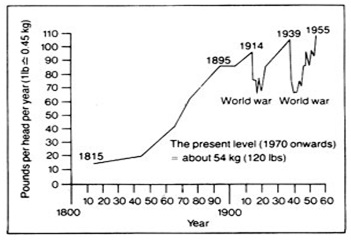 When you hear the word “epidemic” mentioned, it is usually applied to the outbreak of an infectious disease, not a chronic one. However, the alarming increase in the incidence of Type 2 diabetes and in pre-diabetes today has taken on epidemic proportions.
When you hear the word “epidemic” mentioned, it is usually applied to the outbreak of an infectious disease, not a chronic one. However, the alarming increase in the incidence of Type 2 diabetes and in pre-diabetes today has taken on epidemic proportions.
Incidence
The website of the American Diabetes Association (http://www.diabetes.org/diabetes-basics/diabetes-statistics/ ) reports that 25.8 million people in the United States ( 8.3% of the population ) have diabetes. Of these, 18.8 million people are diagnosed and 7.0 million people undiagnosed. In addition, 79 million people are estimated to be pre-diabetic. In 2010, 1.9 million new cases of diabetes were diagnosed in people aged 20 years and older in 2010. If we add up the total numbers of diabetic and pre-diabetic cases, we have over 100 million people, approximately one-third of the total U. S. population. This is obviously a national tragedy.
What is Diabetes?
Diabetes is characterized by the presence of a high blood glucose level resulting from a defect, either in the production of the hormone insulin or in its mechanism of action. In a healthy person, insulin enables cells of the liver, muscle and fat tissue to take up glucose from the blood. In the diabetic patient, this process is impaired.
How is Diabetes diagnosed?
Diabetes is defined by the presence of a blood glucose level of 126 milligrams per deciliter (mg/dL) or more after an overnight fast, or by a non-fasting glucose level greater than or equal to 200 (mg/dL), or a Hemoglobin A1C greater than or equal to 6.5%. Diabetes must be confirmed by meeting at least two of these test criteria, or by repeating one of these tests on a different day.
Pre-diabetes exists when the blood glucose level lies between 100 and 125 mg/dL after an overnight fast, or by having a Hemoglobin A1C level between 5.7% and 6.4%.
The usefulness of measuring Hemoglobin A1C is that it gives a reading of the amount of glucose bound to Hemoglobin in red blood cells and is thus a record of the level of blood glucose during the lifetime of these cells which can last up to four months.
Types of Diabetes
Diabetes is classified into three types.
Type I: Insulin is not produced because the Beta cells of the pancreas have been destroyed by an autoimmune action.
Type II: Insulin is produced but is unable to exert its mechanism of action and so glucose is not taken up efficiently by the cells.
Gestational: This occurs during 3-10% of pregnancies, depending upon the population studied. It reverses after delivery though could indicate a risk for future diabetes.
So what’s happening?
Food and drink are consumed. Carbohydrates are broken down to simple sugar molecules; principally glucose and fructose. These sugars are absorbed by the intestine and end up in the blood stream where they perfuse the tissues. Fructose is converted into fat or otherwise processed in the liver. Glucose is the preferred food of virtually every human cell and with the aid of insulin is absorbed by them, except in Diabetes.
Insulin and the Pancreas
Insulin is a hormone produced by the Beta cells of the pancreas in response to an increase in blood glucose levels. Located deep in the abdomen, the pancreas serves a dual purpose. It produces digestive enzymes which pass into the intestine and it also makes hormones which enter the blood stream and exert their effects at other locations.
Consequences of High Blood Glucose: Glycation
High blood glucose levels such as are seen in diabetes, can lead to a process called glycation where the glucose binds to proteins and alters their function. Glycation changes the shape and properties of proteins by causing crosslinking which reduces their flexibility, elasticity, and functionality. Furthermore, the chemical modifications of glycation and crosslinking can initiate harmful inflammatory and autoimmune responses. Glycation has been found to occur in connective tissue collagen, arterial collagen, kidney glomerular basement membrane, eye lens crystallins, nerve myelin proteins and in circulating low-density lipoproteins (LDL).
Symptoms of Diabetes
Excessive hunger and thirst
Frequent urination
Unusual weight gain or loss
Fatigue
Nausea
Blurred vision
Yeast infections in the urinary tract
Slow healing of sores, cuts and bruises
Numbness or tingling in the hands and feet
Consequences of Diabetes
These are very serious indeed and include:
Increased Risk of Heart Disease and Stroke
Peripheral Arterial Disease – Risk of Amputations
Chronic Kidney Disease and Kidney Failure
Neuropathy affecting the Nerves supplying Limbs and Organs
Eye Disease – Risk of Blindness
Impotence
Risk Factors for Diabetes
Family history of Diabetes
High fructose intake
High blood pressure
High blood triglyceride (fat) levels
Previous Gestational Diabetes or giving birth to a baby weighing more than 9 pounds
Eating a high-fat diet
Having a high alcohol intake
Living a sedentary lifestyle
Being overweight ( BMI 25 – 29.9 ) or obese ( BMI 30 + )
Ethnicity: Certain groups, such as African Americans, Native Americans, Hispanic Americans, and Japanese Americans, have a greater risk of developing Type 2 Diabetes than Caucasians.
Aging: Increasing age is a significant risk factor for Type 2 Diabetes. The risk of developing Type 2 Diabetes begins to rise significantly at about age 45 years and rises considerably after age 65 years.
What is the Cause?
Judging from the list of risk factors above, the very high frequency of diabetes observed today is very much linked to our lifestyle. There also appears to be a genetic component. The average sugar consumption per capita has increased significantly over the past two centuries, as can be seen from the graph below, compiled from data in the U.K. It is now estimated that individual sugar consumption in the U.S.A. may be as high as 150 pounds per year, representing an average intake of three pounds per week.
Prevention and Cure
Thanks to the work of Dr. Neal Barnard and others, the good news is that Type II Diabetes can be both prevented and reversed. Most of Dr. Barnard’s work has centered on diet and the key conclusions he has reached can be summarized as follows:
Avoid animal products – and therefore reduce your animal fat to intake to zero.
Keep vegetable oils to a minimum – limit nuts, seeds, olives, avocados and full fat soy products.
Favor high-fiber foods. Focus on beans and other legumes, vegetables, fruits and whole grains.
How to Get Started.
1. Make the commitment.
2. Write it down.
3. Don’t be afraid to ask for help.
4. Talk with your physician.
5. Buy Dr. Barnard’s book.
6. Find a partner or group, for support and accountability.
7. Buy fresh organic or unsprayed produce.
8. Get a good recipe book and share recipes.
References
American Diabetes Association (2012) Diabetes Statistics http://www.diabetes.org/diabetes-basics/diabetes-statistics/
Barnard, Neal. (2007) Dr. Neal Barnard’s Program for Reversing Diabetes: The Scientifically Proven System for Reversing Diabetes Without Drugs. Rodale, New York.





Comments on this entry are closed.